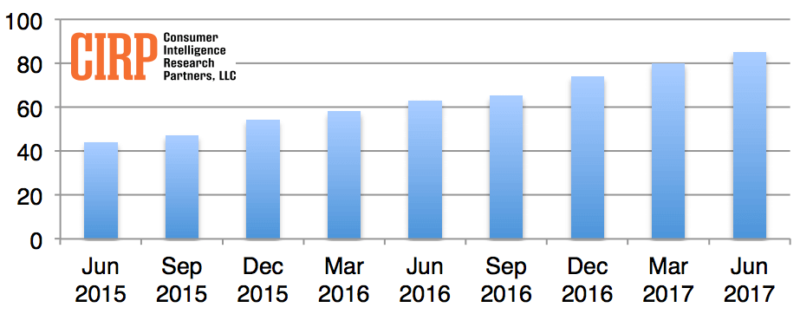Amazon’s latest marketing and sales growth strategy: a social platform
Amazon is getting into Instagram and Pinterest territory with its new network aimed at driving engagement that revolves entirely around products.
Amazon debuted a new social feed called Spark on the iPhone in the US this past week. A little bit Pinterest, a lotta bit Instagram, Amazon has set up Spark to potentially do a number of things for the marketplace.
Here are five ways the Spark platform is poised to boost Amazon’s already booming business, and what it means for Amazon’s — and their partners’ — marketing strategy:
1. Facilitate product discovery
This is the most obvious benefit Spark can bring to Amazon and its partners. After users identify at least five interests to follow, their Spark feeds are filled with images of products related to their stated interests. From the Explore section, users can discover trending posts and dig into other interest categories.
Spark could also help Amazon continue to dig into Google’s share of product search. Several surveys have highlighted the jockeying between the two internet giants as the first place consumers go when they are looking to buy a product. Spark could give Amazon another avenue for consumers to leapfrog the search engine.
2. Drive social engagement that revolves around social commerce
While other social networks have struggled to make social commerce work at massive scale, Amazon can approach it from the opposite angle and build a social network on top of the biggest ecommerce marketplace in the US. Unlike a Walmart.com or Target.com, for example, there has always been a social aura to Amazon with its reviews, customer images, and Prime memberships ingraining a kind of sense of belonging within the platform’s experience.
As the Wall Street Journal has reported, Amazon is paying influencers and publishers like Apartment Therapy to post on the new network. Images on Spark can be tagged to be shoppable right within Amazon. A little shopping bag icon in the bottom right corner of an image tells users how many items that have been tagged are available for purchase from Amazon.
Spark could also drive up engagement — and orders — among younger audiences. Spark supports video and you can bet that Amazon is wise to the incredible popularity of “un-boxing” and tutorial videos on YouTube and sees Spark as the natural place for those kinds of videos.
3. More reliable product reviews & recommendations (maybe)
Amazon has long battled the market for fake product reviews, suing both buyers and sellers and cracking down on incentivized reviews in its Vine program. To post on Spark, users must be Prime members and have spent a minimum of $50 on Amazon. Theoretically, that should raise the bar for writing reviews, and Verified Purchase reviews from customers that have actually bought the product can show up in Spark.
But the social network is already filled with posts labeled #Sponsored (and others that probably should be — looking at you, Bob Vila) and if it launches an affiliate-style program for Spark contributors, the promotion could overwhelm any sense of authenticity. It appears more likely Spark will just one more place Amazon will have to police those trying to game the system. Quality could plague the network in another area too: posts can be tagged with products that don’t match what’s in the image, as shown in the example below.
4. Promote Prime memberships
Prime membership has been the glue that keeps customers coming back to Amazon, over and over again. As my colleague, Greg Sterling noted in the wake of Prime Day this year, with more than 85 million members, Prime may be the most effective loyalty program ever. Just as you must be a member to access Prime Day deals, the ability to engage on Spark is for Prime members only. And of course, many items tagged in Spark images are Prime eligible, providing yet another avenue to drive home incentive to join the program. Prime subscribers spend nearly twice as much as non-members on Amazon annually: $1,300 versus $700, according to Consumer Intelligence Research Partners (CIRP).
5. Data collection & ads when the time is right
A key reason Facebook been so successful in rapidly building its advertising business is the interest targeting it offers advertisers. Spark users have to select a minimum of five interests when they sign up. These selections inform what users see in their Spark feeds, and gives Amazon a whole new set of signals for audience targeting down the road. Amazon already knows what users search for and buy, now it can learn about interests and aspirations that can inform ad campaigns throughout the sales funnel.
Just as Facebook slowly and methodically introduced ads in Instagram, and now Messenger, Amazon doesn’t have to be in a rush to introduce ads to Spark. In the meantime, it can collect and analyze interest data for surfacing advertising and promotions to users on the marketplace.
There are many reasons to be skeptical that users will gravitate to Spark and that it will succeed. On the other hand, Amazon has time and again proven it can grind out a winning formula where others have struggled and that it knows how to keep its customers loyal, engaged, and growing in number.

Contributing authors are invited to create content for MarTech and are chosen for their expertise and contribution to the martech community. Our contributors work under the oversight of the editorial staff and contributions are checked for quality and relevance to our readers. MarTech is owned by Semrush. Contributor was not asked to make any direct or indirect mentions of Semrush. The opinions they express are their own.
Related stories


